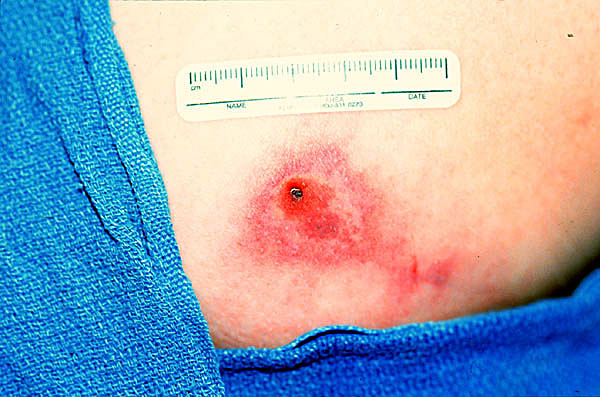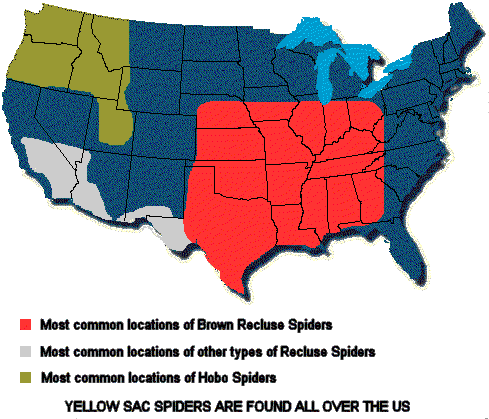Category: Toxicology
Keywords: organophosphates, intermediate syndrome (PubMed Search)
Posted: 9/6/2012 by Ellen Lemkin, MD, PharmD
Click here to contact Ellen Lemkin, MD, PharmD
Category: Pharmacology & Therapeutics
Keywords: Uti,bactrim,smx/tmp,ciprofloxacin,levofloxacin (PubMed Search)
Posted: 8/2/2012 by Ellen Lemkin, MD, PharmD
Click here to contact Ellen Lemkin, MD, PharmD
Acute, uncomplicated cystitis (in the non-pregnant female):
· The drug of choice is SMX/TMP (provided the resistance rate is <20%) X 3 days.
· An alternative is nitrofurantoin X 5 days.
Acute, uncomplicated pyleonephritis (in the non-pregnanct female) may be treated with:
· Levofloxacin X 5 days, or ciprofloxacin X 7 days (provided resistance rate is <10%).
· Alternatively, SMX/TMP may be used X 14 days.
The Medical Letter. July 23, 2012. Vol 54(1395):57-60.
Category: Toxicology
Keywords: envenomation,stings,jellyfish (PubMed Search)
Posted: 7/5/2012 by Ellen Lemkin, MD, PharmD
Click here to contact Ellen Lemkin, MD, PharmD
No one treatment has demonstrated consistency of pain relief from jellyfish stings over all species; conversely, a treatment for one species may worsen an envenomation from another.
Deionized water, seawater, meat tenderizer, and urea treatment do not appear to produce any improvement in pain sensation.
Ammonia, acetic acid, and ethanol may cause an increased stinging sensation, and in most species vinegar may cause nematocyst discharge.
Application of topical lidocaine reduced the local sensation of pain (10% and 15% produced immediate pain relief), and hot water results in pain relief in the majority of patients tested.
Ward NT, Darracq MA, Tomasewski C, Clark RF. Evidence-Based Treatment of Jellyfish Stings in North America and Hawaii. Article published online, Annals of Emergency Medicine June 8, 2012.
Category: Toxicology
Keywords: Warfarin,vitamin K,coagulation,INR,supratherapeutic (PubMed Search)
Posted: 6/7/2012 by Ellen Lemkin, MD, PharmD
Click here to contact Ellen Lemkin, MD, PharmD
It may not be necessary to give oral vitamin K to patients that are not bleeding that have INRs between 4.5 and 10.
Patients who were supratherapeutic on warfarin were randomized to vitamin K 1.25 mg (n=355) versus placebo (n=369).
In the 90 days after enrollment, 15.8% of patients allocated to vitamin K and 16.3% allocated to placebo had a bleeding event. Major bleeding events occurred in 9 patients in the vitamin K group and 4 in the placebo.
Thromboembolic events occurred in 1.1% of patients in the vitamin K group, compared to 0.8% of patients in the placebo group. An equal number of patients died in each group (n=7).
Crowther MA, Ageno W, Garcia D, et. al. Oral Vitamin K Versus Placebo to Correct Excessive Anticoagulation in Patients Receiving Warfarin. Ann Intern Med 2009, 150:293-300.
Category: Pharmacology & Therapeutics
Keywords: MRSA, antibiotic, pneumonia, VAP, cephalosporin, infection (PubMed Search)
Posted: 5/3/2012 by Ellen Lemkin, MD, PharmD
Click here to contact Ellen Lemkin, MD, PharmD
If vancomycin resistance is suspected with MRSA infections, there are several other antibiotic choices. They are all extremely expensive.
| Antibiotic | ORAL | Indication | Precaution |
| Telavancin | N | SSTI | May cause QT prolongation: Caution with azole antifungals, class III antiarrhythmics, antidepressants, antipsychotics. Interferes with coagulation tests. |
| Daptomycin | N | SSTI Bacteremia Endocarditis | Not for pneumonia. May cause rhabdomyolysis; Discontinue statins. |
| Linezolid | Y | VAP SSTI | Not for bacteremia. May cause serotonin syndrome; Caution with antidepressants, antipsychotics, tramadol, methadone. |
| Tigecycline | N |
Intrabdominal infections SSTI | Not for bacteremia. Inhibits clearance of warfarin. Reserve for polymicrobial infections. |
Skin and soft tissue infection (SSTI); ventilator acquired pneumonia (VAP)
Category: Toxicology
Keywords: protamine, enoxaparin, Xa (PubMed Search)
Posted: 4/5/2012 by Ellen Lemkin, MD, PharmD
Click here to contact Ellen Lemkin, MD, PharmD
Protamine for enoxaparin overdose
Category: Toxicology
Keywords: Octreotide, sulfonylurea, glucose, insulin (PubMed Search)
Posted: 3/1/2012 by Ellen Lemkin, MD, PharmD
Click here to contact Ellen Lemkin, MD, PharmD
Dougherty PP, Klein-Schwartz W. J. Med Toxicol 2010;6:199-206.
Category: Pharmacology & Therapeutics
Keywords: ondansetron, zofran, prolonged QT, torsades, drug interactions, ciprofloxacin, antifungal, azoles (PubMed Search)
Posted: 2/2/2012 by Ellen Lemkin, MD, PharmD
Click here to contact Ellen Lemkin, MD, PharmD
Category: Pharmacology & Therapeutics
Keywords: MRSA, antibiotic, pneumonia, CAP, cephalosporin, infection (PubMed Search)
Posted: 1/5/2012 by Ellen Lemkin, MD, PharmD
Click here to contact Ellen Lemkin, MD, PharmD
Resistance is expected to be limited, with the exception of VRE, and VSE (vanco resistant or sensitive enterococcus faecalis)
Renally excreted
Common side effects: diarrhea, nausea, headache
Serious side effects: anaphylaxis, renal failure, hepatitis, seizure
Low incidence of C. difficile
Dose : 600 mg IV (over 1 hour) q12 hours X 5-7 days
Category: Toxicology
Keywords: Insulin,beta blockers,calcium channel blockers (PubMed Search)
Posted: 12/1/2011 by Ellen Lemkin, MD, PharmD
Click here to contact Ellen Lemkin, MD, PharmD
High dose insulin is recommended in treatment of beta-blocker and calcium channel blocker overdose. In a recent observational case series of cardiogenic shock, high dose insulin was evaluated for efficacy and safety.
Holger JS, Stellpfug SJ, Cole JB, Harris CR, Engebretsen KM. High-Dose Insulin: A Consecutive Case Series in Toxin-Induced Cardiogenic Shock. Clinical Toxicology Aug 2011;49(7):653-8.
Category: Toxicology
Keywords: salicylate, aspirin, alkalosis, acidosis (PubMed Search)
Posted: 11/3/2011 by Ellen Lemkin, MD, PharmD
(Updated: 12/18/2025)
Click here to contact Ellen Lemkin, MD, PharmD
Salicylates:
Overall, this results in a mixed respiratory alkalosis and metabolic acidosis.
Micromedex; Poisindex, salicylate poisoning.
Category: Pharmacology & Therapeutics
Keywords: Intranasal administration,fentanyl,ketorolac,sumatriptin,glucagon,desmopressin,midazolam (PubMed Search)
Posted: 10/6/2011 by Ellen Lemkin, MD, PharmD
Click here to contact Ellen Lemkin, MD, PharmD
There are an increasing number of intranasal medications commercially available for use, which is opportune as more and more intravenous medications become scarce.
These now include:
| Generic name | Brand Name | Usage |
| Fentanyl | Instanyl | Opiate analgesic |
| Ketorolac | Sprix | NSAID analgesic |
| Desmopressin (DDAVP) | Stimate | Bleeding |
| Vitamin B12 | Nasobal | Anti-migraine (yes!) |
| Sumatriptan | Imitrex | Anti-migraine |
| Zolmitripran | Zomig | Anti-migraine |
*******In addition, you can administer glucagon, midazolam and narcan intranasally as well.
Veldhorst-Jassen, NM, Fiddelers AA, Paul-Hugo M et all. A review of the clinical pharmacokinetics of opioids, benzodiazepines, and antimigraine drugs delivered intranasally. Clinical Therapeutics Nov 12, 20009;31(12):2954-87.
Wolfe TR, Braude DA. Intranasal Medication Delivery for Children: A Brief Review and Update. Pediatrics 2010;126;532:532-7.
Category: Pharmacology & Therapeutics
Keywords: thrombin,dabigatran,partial thromboplastin,bleeding (PubMed Search)
Posted: 9/1/2011 by Ellen Lemkin, MD, PharmD
(Updated: 12/18/2025)
Click here to contact Ellen Lemkin, MD, PharmD
Rye J, Stangier J, Haertter S, et al. Dabigatran etexilate - a novel, reversible, oral direct thrombin inhibitor: Interpretation of coagulation assays and reversal of anticoagulant activity. Thrombosis and Haemostasis 2010. 103;1116-27.
Category: Toxicology
Keywords: acetaminophen,pain (PubMed Search)
Posted: 8/4/2011 by Ellen Lemkin, MD, PharmD
Click here to contact Ellen Lemkin, MD, PharmD
o The FDA is now asking manufacturers to limit the amount of acetaminophen in combination products to 325 mg per dose.
o The higher dose formulations will be phased out by 2014.
o The FDA is also considering lowering the maximum total to 3 gm per day, and a maximum dose of 650 mg per dose
o This does not pertain to OTC, but this is likely to change in the near future; Johnson & Johnson (manufacturer of Tylenol) has already adopted these recommendations.
Category: Toxicology
Keywords: caffeine, arrhythmias, cardiac (PubMed Search)
Posted: 7/7/2011 by Ellen Lemkin, MD, PharmD
(Updated: 12/18/2025)
Click here to contact Ellen Lemkin, MD, PharmD
Animal studies show high doses of caffeine produces catecholamine triggered activity
Small studies in high risk patients (recent MI, malignant arrhythmias) have shown no increase in frequency or severity of arrhythmia
No large scale human studies exist evaluating caffeine's effects on patients with malignant arrhythmias (VF/VT)
Overall, the data suggest that caffeine is well tolerated in moderate doses in most patients, even those with known or suspected arrhythmias
In patients who claim sensitivity to caffeine, or in those with known arrhythmias where catecholamines are felt to drive the arrhythmia, caffeine may be discouraged by physicians.
Category: Pharmacology & Therapeutics
Keywords: acetaminophen,pain,narcotic,Ofirmev,intravenous (PubMed Search)
Posted: 5/5/2011 by Ellen Lemkin, MD, PharmD
Click here to contact Ellen Lemkin, MD, PharmD
IV acetaminophen has been approved for use since November 2010
It is indicated for the:
The results of studies demonstrating opoid sparing effects have been mixed; some studies have not demonstrated either a reduction in opioid dose or opioid side effects.
The dose is the same for acetaminophen administered by other routes.
It must be administered over 15 minutes, and onset of activity is 15 minutes. Peak effect occurs at one hour.
The MAJOR drawback is the cost, which is $13 dollars per vial. This is compared to oral acetaminophen and ibuprofen, which are pennies.
Pharmacist's letter/Prescriber's letter Detail document #270212. February 2011 72:270212
Category: Toxicology
Keywords: radiation, iodide, KI, thyroid, iodine-131 (PubMed Search)
Posted: 4/7/2011 by Ellen Lemkin, MD, PharmD
Click here to contact Ellen Lemkin, MD, PharmD
· In the event a nuclear power plant accident, people may be exposed to a mixture of radioactive products. The main radionuclides representing health risk are radioactive caesium and radioactive iodine.
· Iodine-131 is concentrated in the thyroid gland and may eventually lead to development of thyroid nodules and thyroid cancer.
· Radioiodine uptake by the thyroid can be blocked by taking potassium iodide (KI) pills or solution, preventing these effects.
· KI should not be taken in the absence of a clear risk of exposure to a potentially dangerous level of radioactive iodine because KI can cause allergic reactions, skin rashes, salivary gland inflammation, hyperthyroidism or hypothyroidism.
· Since radioactive iodine decays rapidly, current estimates indicate there will not be a hazardous level of reaching the United States from this accident.
· There are three FDA approved KI products: Iosat, Thyrosafe and ThyroShield.
http://www.who.int/hac/crises/jpn/faqs/en/index2.html
briefs.com/briefs/ATAORG/ATAORG031611.php
Pharmacist's Letter April 2011 Vol 27(4) 19-20.
Category: Toxicology
Keywords: Brown Recluse,envenomation,spider,loxoscelism (PubMed Search)
Posted: 3/3/2011 by Ellen Lemkin, MD, PharmD
Click here to contact Ellen Lemkin, MD, PharmD
Recently a case report was published in which a child was incorrectly diagnosed with MRSA. He actually had systemic loxoscelism from a Brown Recluse spider bite.
A patient who has been bitten by brown recluse spider bite may present with pruritis, pain and swelling. The classic lesion has a bluish-purple central region, surrounded by concentric rings of pale ischemia and erythema. (“red, white and blue”) Bites may progress over days to a bleb with necrosis and eschar formation, followed by ulceration.
Systemic loxoscelism presents with a scarlatiniform rash that spreads dependently. It may have the classic purple lesion surrounded by concentric rings of pale ischemia and erythema. The patient may be uncomfortable but is usually stable. Treatment is supportive care.


Rogers, KM, Klotz CR, Jack M, Seger D. Systemic Loxoscelism in the Age of Community-Acquired Methicillin-Resistant Staphylococcus aureus. Ann of EM Feb 2011 57(2); 138-40.
Category: Toxicology
Keywords: Methemoglobinemia,methylene blue (PubMed Search)
Posted: 2/3/2011 by Ellen Lemkin, MD, PharmD
(Updated: 12/18/2025)
Click here to contact Ellen Lemkin, MD, PharmD
Category: Toxicology
Keywords: Vitamin K1,anaphylaxis,coumadin,warfarin (PubMed Search)
Posted: 1/6/2011 by Ellen Lemkin, MD, PharmD
(Updated: 12/18/2025)
Click here to contact Ellen Lemkin, MD, PharmD
Smythe MA, Dager WE, Patel NM. Managiing Complications of Anticoagulation Therapy. Journal of Pharmacy Practice 200417(5)327-46.
Dentali F, Crowther MA. Management of Excessive Anticoagulant Effect Due to Vitamin K Antagonists. Hematology 2008;266-9.
DeZee K et all. Treatment of Excessive ANticoagulation with Phytodione. Arch Intern Med Feb 27, 2006;166:391-7.
